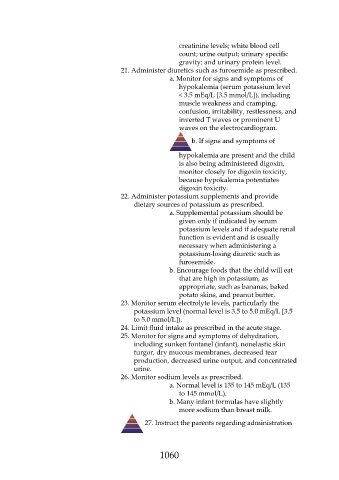Page 1060 - Saunders Comprehensive Review For NCLEX-RN
P. 1060
creatinine levels; white blood cell
count; urine output; urinary specific
gravity; and urinary protein level.
21. Administer diuretics such as furosemide as prescribed.
a. Monitor for signs and symptoms of
hypokalemia (serum potassium level
< 3.5 mEq/L [3.5 mmol/L]), including
muscle weakness and cramping,
confusion, irritability, restlessness, and
inverted T waves or prominent U
waves on the electrocardiogram.
b. If signs and symptoms of
hypokalemia are present and the child
is also being administered digoxin,
monitor closely for digoxin toxicity,
because hypokalemia potentiates
digoxin toxicity.
22. Administer potassium supplements and provide
dietary sources of potassium as prescribed.
a. Supplemental potassium should be
given only if indicated by serum
potassium levels and if adequate renal
function is evident and is usually
necessary when administering a
potassium-losing diuretic such as
furosemide.
b. Encourage foods that the child will eat
that are high in potassium, as
appropriate, such as bananas, baked
potato skins, and peanut butter.
23. Monitor serum electrolyte levels, particularly the
potassium level (normal level is 3.5 to 5.0 mEq/L [3.5
to 5.0 mmol/L]).
24. Limit fluid intake as prescribed in the acute stage.
25. Monitor for signs and symptoms of dehydration,
including sunken fontanel (infant), nonelastic skin
turgor, dry mucous membranes, decreased tear
production, decreased urine output, and concentrated
urine.
26. Monitor sodium levels as prescribed.
a. Normal level is 135 to 145 mEq/L (135
to 145 mmol/L).
b. Many infant formulas have slightly
more sodium than breast milk.
27. Instruct the parents regarding administration
1060

